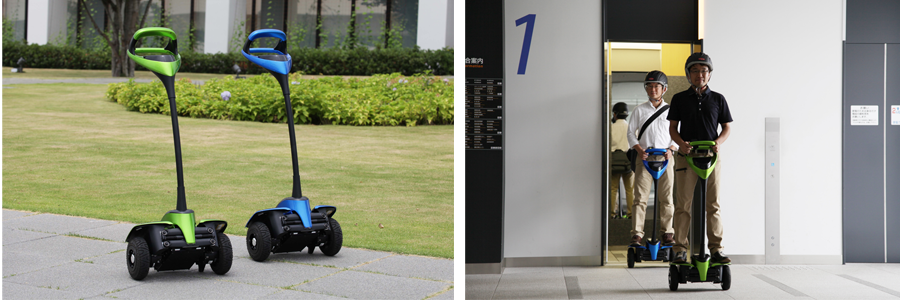“Winglet” Goes Public in Japan
13 Aug 2013

Toyota Mobility Assistance Robot “Winglet” Goes Public in Japan
Mobility-robot-using communities across the world a not-to-distant possibility with trials to end in March 2016
Winglet will be assessed for safety, convenience, practicality and public reaction
Key countermeasure in reducing transportation sector’s contribution to climate change with zero-emissions thanks to lithium-ion battery power
Kuwait, August 13, 2013: Toyota has announced public sidewalk demonstration trials of the “Winglet”, a personal transport assistance robot developed by the company, in Japan’s Tsukuba City, to assess its safety and practicality for moving among pedestrians. It will be used by 80 local authority workers and employees of the National Institute of Advanced Industrial Science and Technology in a part of the city that has been hosting mobility robot test programmes since 2011. The trials will continue until the end of March 2016, with the emphasis in the first year being on safety and from 2014 onwards on functionality, convenience and prospective public demand.
Toyota first presented the Winglet in 2008. It is a compact, lightweight two-wheeled machine that is ridden in a standing position and maneuvered using a long, vertical T-bar handle. The handle is adjustable, so people of all heights can use the machine. It is powered by a lithium-ion battery and has a range of about six miles (10km) on a full charge with a top speed of around 3.5mph (6km/h), and battery charging takes an hour. Performance is emissions-free, so the Winglet is also suitable for use in some indoor environments such as airports or office complexes.
Toyota has developed several world-class vehicles that have been appreciated and well-received globally, making it the preferred brand of choice among customers. It has further enhanced its leadership position in the transportation sector with its advancements in personal transportation through the development of people-assisting Toyota Partner Robots. In line with its commitment to environmental sustainability, Toyota introduced the Winglet to support public mobility and invigorate local communities while also improving the environment.
“Toyota has always strived to achieve sustainability in the areas of research and development, manufacturing and social responsibility, to help contribute to the health and comfort of future society. It is with this pursuit in mind that Toyota Partner Robot development is being carried out. With the start of the Winglet trials for the first time on a public thoroughfare, Toyota hopes to contribute to the realization of mobility-robot-using communities with zero emissions”, said Nobuyuki Negishi, Chief Representative of Middle East & North Africa Representative Office, Toyota Motor Corporation.
“Governments across the world are looking at several green solutions to reduce their carbon emissions. The transportation sector is a major contributor to climate change and hence as the world’s biggest manufacturer of vehicles used for personal and commercial purposes, we have always considered it our responsibility to support global warming mitigation efforts through our commitment to our environmental technology plans. Toyota has pioneered and invested in several advanced vehicle technologies and concepts, to reduce carbon emissions, conserve energy and diversify fuel sources, by encouraging the use of electricity, hydrogen and other alternative energies. Toyota has made revolutionary breakthroughs such as hybrid, plug-in hybrid, electric, and hydrogen fuel cell vehicles, wireless battery charging, next generation batteries, and the Winglet among others”, added Negishi.
For the past few years, the developed and the developing worlds have been committed and are actively working towards reducing their carbon footprints through several policy changes, climate change programs, green initiatives, and community-wide awareness programs. In the MENA Region, it is estimated that carbon emissions doubled in the past three decades eliciting several countermeasures by the federal and local governments. The transportation of people and goods creates about one-third of all carbon emissions and hence shifting to the use of alternative fuels, public transportation and alternative means of transportation are some factors that can help reduce the contribution of the transportation sector to these emissions.
Toyota Motor Corporation, the world’s biggest automobile manufacturer has been at the forefront in realizing the need for this shift, investing heavily in terms of financial and human resources to develop technology that supports this change, and making this technology available to the masses. Toyota introduced Prius, the world’s first mass-produced hybrid passenger car in 1997, and has subsequently launched several other hybrid Toyota and Lexus models, with global cumulative sales crossing the 5 million mark earlier this year. In September 2012, Toyota announced plans to launch 21 hybrid models over a three year period.